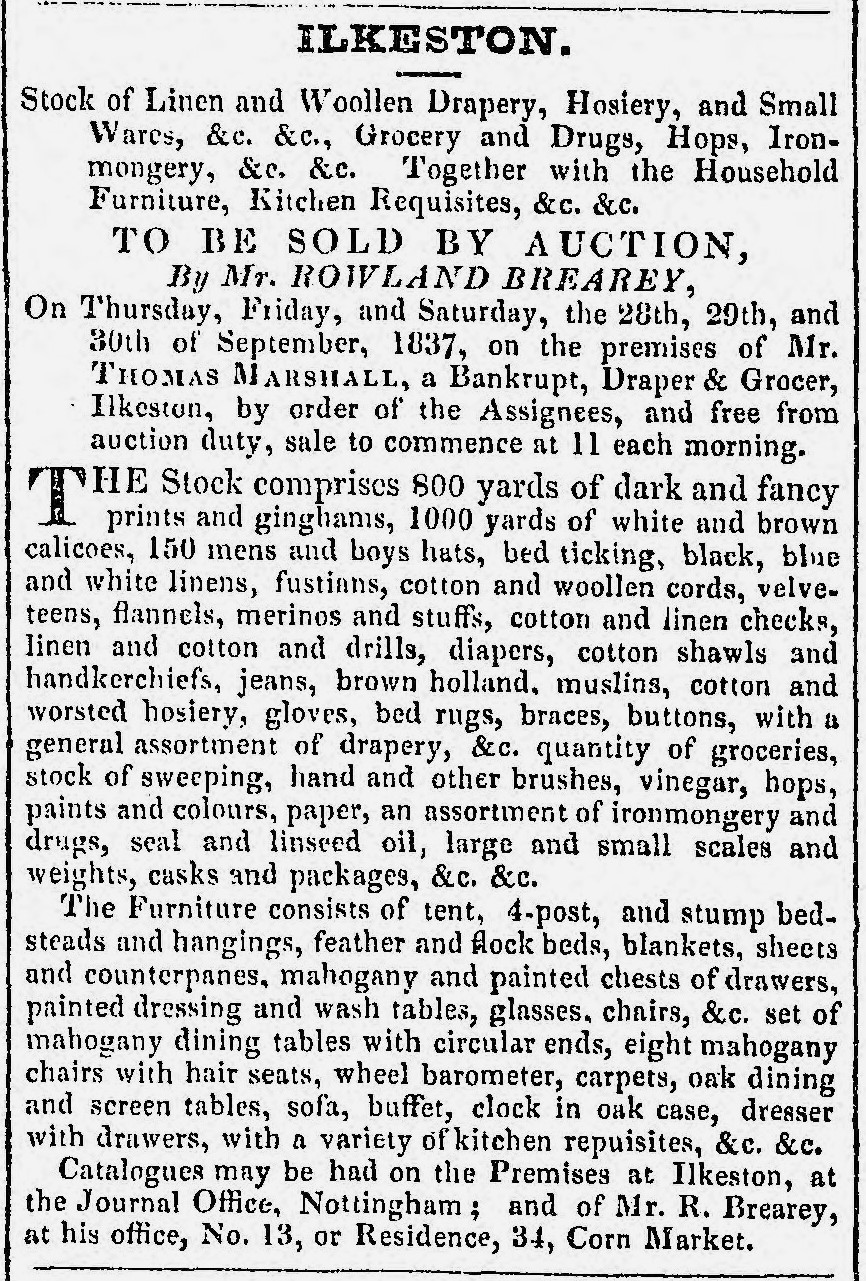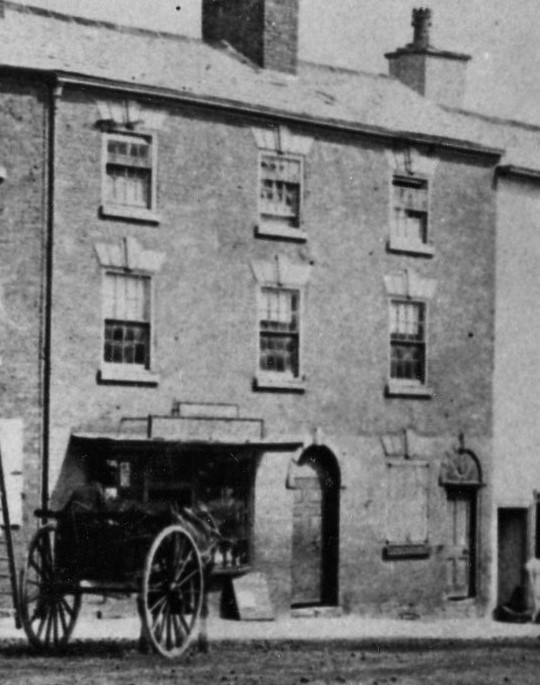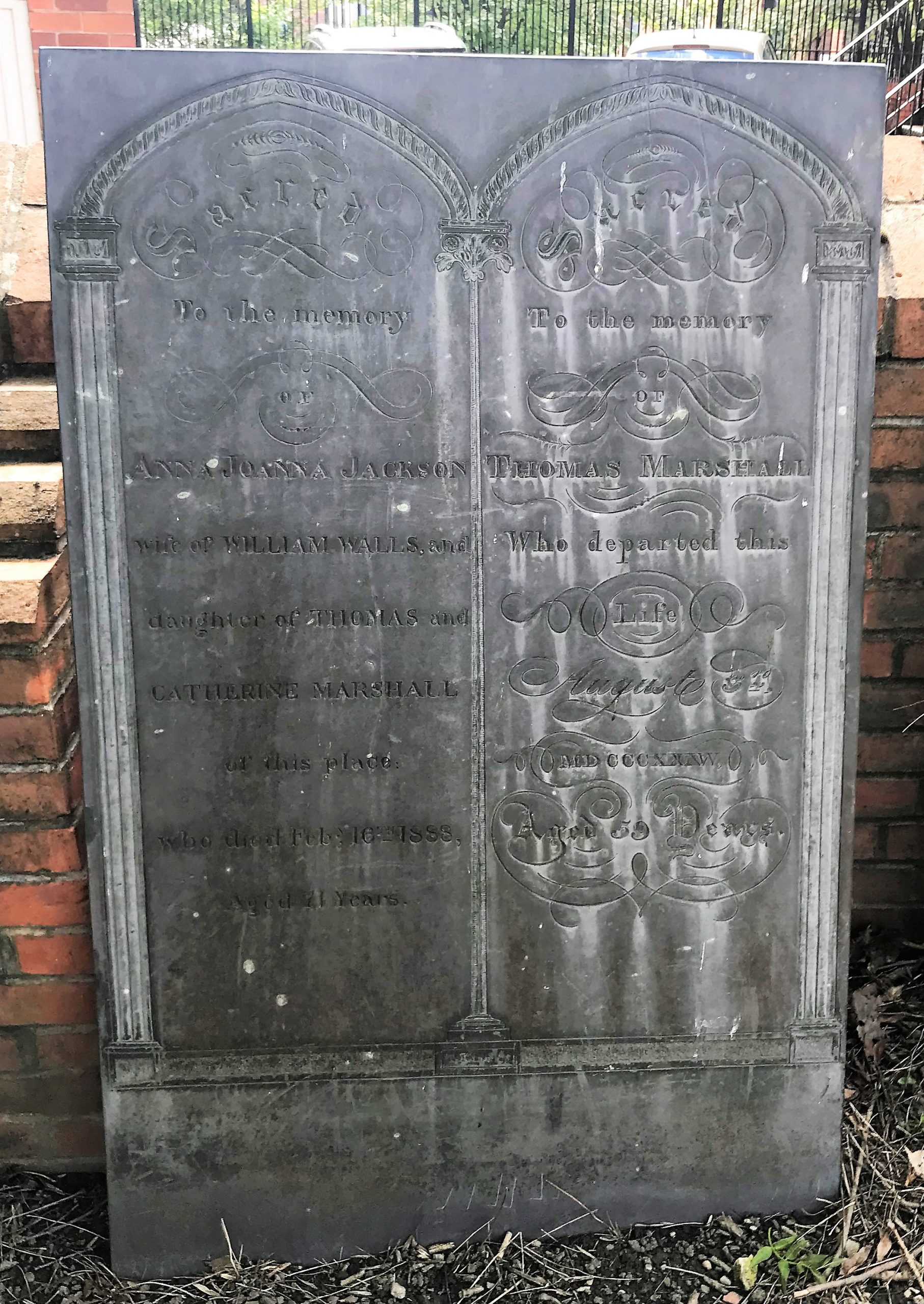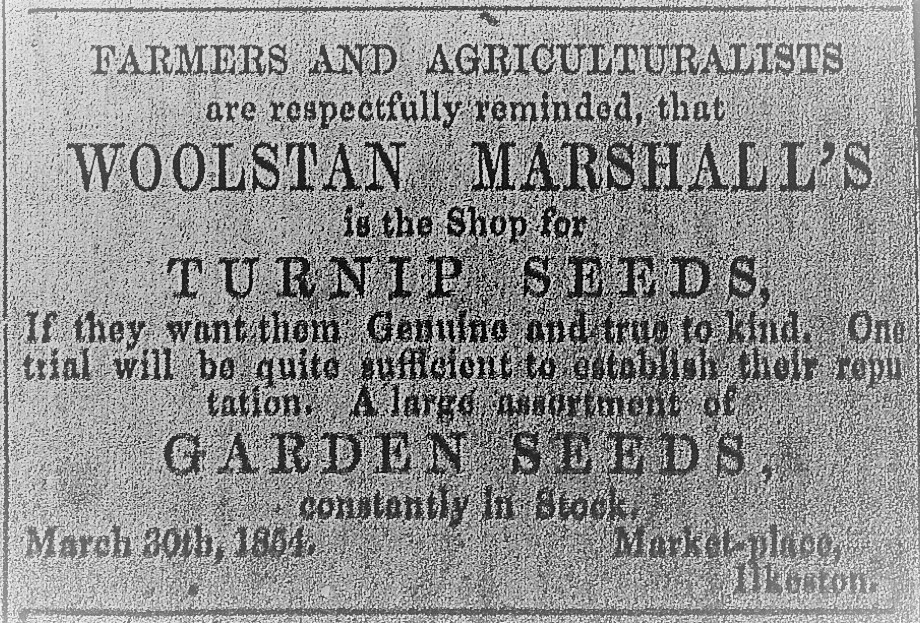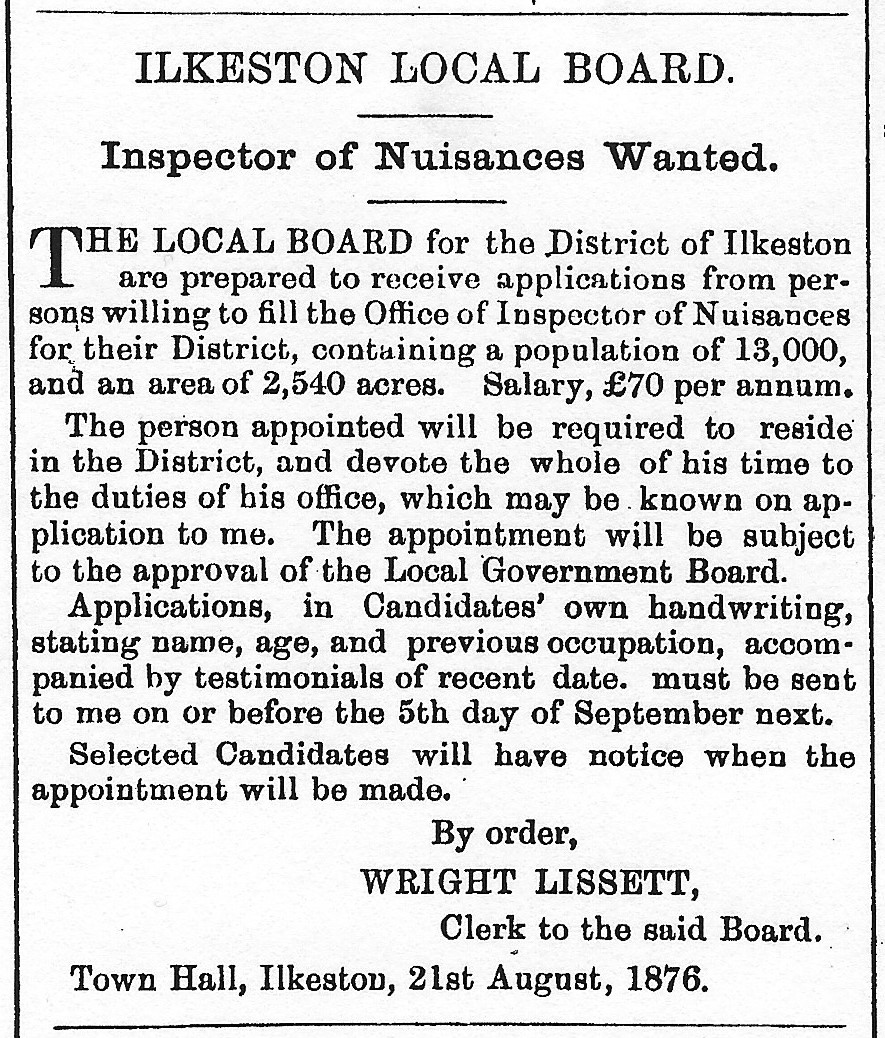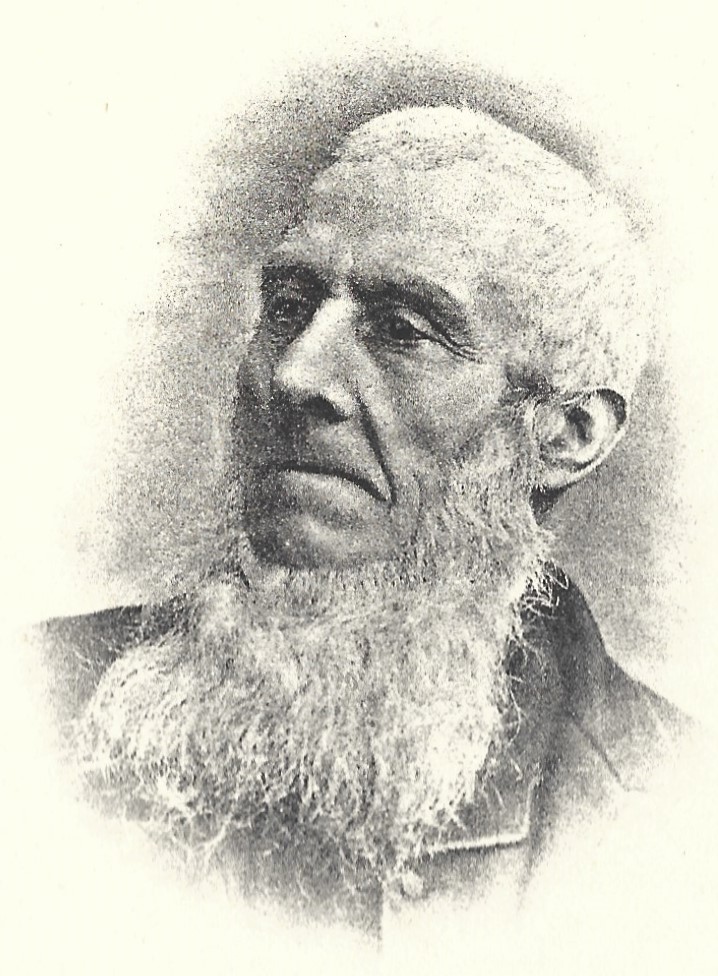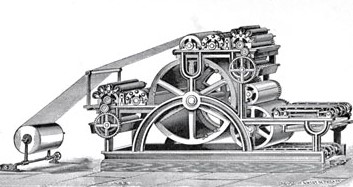After the draper’s shop Adeline leads us to the next property. It adjoins the King’s Head Inn and is occupied as a grocer’s and draper’s shop by the Marshall family (at the dawn of the Victorian period). It was later numbered 6 Market Place for the census of 1871, by which time the Marshall family had left.
The head of the Marshall family at the dawn of the Victorian Age was Thomas (c1786-1845) who married Catherine Jackson on February 7th, 1813. She was the daughter of victualler William Jackson and Anna Joanna (nee Battille).
In the late 1830s Thomas was in financial difficulties — bankrupt and forced to liquidate (below)
Derby Mercury (September 20th 1837)
The shop next to the King’s Head pictured a few years after the departure of the Marshalls and then occupied by John Wombell
For nearly three years Thomas’s eldest son, Thomas junior, traded as a grocer at the Market Place premises but in July 1844, and just like his father, he too was in financial difficulties and gave up the business. On April 3rd, 1849 he married Emily Aldred, daughter of baker Robert and Mary (nee Ingram) and then departed Ilkeston.
Thomas Marshall senior died on August 3rd, 1845 and was buried at St. Mary’s Church.
Thomas’s grave marker can be seen there, against the wall on the south side.
His inscription, on the right of the slate, reads …
Sacred to the memory of Thomas Marshall who departed this life August 3rd MDCCCXXLXV aged 59 years.
—————————————
It also commemorates one of his daughters ….
Sacred to the memory of Anna Joanna Jackson wife of William Walls,
and daughter of Thomas and Catherine Marshall of this place:
who died Feb 16th 1888, aged 71 years.
————————————————————————————————————————-
Woolstan Marshall (1825-1878)
When Thomas died in August 1845, his son Woolstan continued the grocery business while his younger brother Robert sold meat there, to go with the ‘veg.’ However Robert later moved into South Street to set up his own butcher’s shop there. Adeline refers to Woolstan as an “acorn dealer and seedsman”
Sheddie Kyme remembers that Woolstan’s shop had ‘roundly-bowed windows, the panes of which were the small cottage pattern in vogue at that time’. And Adeline remembers something similar …”the shop had two small bow windows.”
In 1851 Woolstan made a visit to the Great Exhibition in London with friend Ezekiel Bailey, both in their twenties.
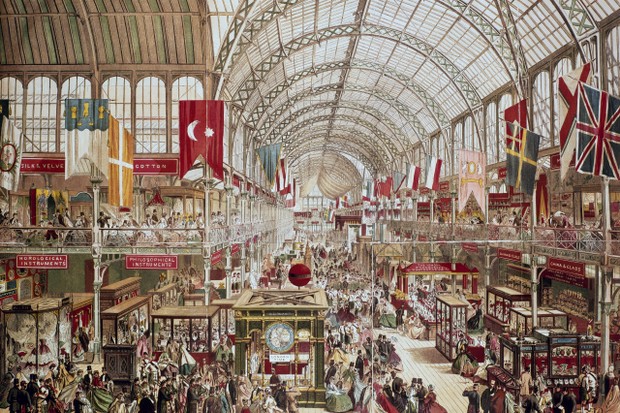
“On arrival in London they went to a shop to get a cigar. It so happened that each put down half-a-crown. Not receiving any change they made bold to ask for it.
“But the young lady who waited upon them politely informed them, ‘Times changed, faces changed, and all things changed, but they’d get no change from her’”. (Enquirer. 1892).
In 1857 Woolstan Marshall’s garden in the Market Place was raided by a thief, who took 25 gooseberry and currant trees. Woolstan was driven to exclaim that if he could catch the culprit he would ensure that “he would not have borne the sight of either gooseberry or currant dumplings for the remainder of his life”.
In 1859 Woolstan married Ann Barker, elder daughter of John Barker, the proprietor of the Bridge Inn premises on Awsworth Road, and Sarah (nee Smallwood), and the couple then lived next to Woolstan’s mother in the Market Place.
Woolstan and John Wombell, proprietor of the Ilkeston Pioneer, met in controversial and disputed circumstances during one October evening in 1861 at the Market Tavern.
John claimed to have seen an intoxicated Woolstan staggering around the Market Place, visiting the Market Tavern and Harrow Inn, and eventually being helped home by Joseph Aldred, landlord of the Harrow. At one point during these perambulations — at the Market Tavern — Woolstan had entered into an argument with John and had thrown liquor of an unspecified nature into the latter’s eyes, inciting John to retaliate by punching Woolstan.
The two sued each other and met in court with John conducting his own case – as usual!!
He presented his case first and called several witnesses who all appeared not to have read his script. None of them could confirm Woolstan being drunk and before John could make a statement, the Judge, perhaps running out of patience, dismissed the case against the grocer, (a case which was not reported in the Ilkeston Pioneer, of which John Wombell was proprietor, remember !!).
At the beginning of 1862 Woolstan was discharged from his bankruptcy of the previous year.
In late 1863 Woolstan and his wife Ann were separated, the latter and their daughter, two year old Catherine Sarah, going to live with her parents at the Bridge Inn on Awsworth Road. At this time Woolstan had been having ‘financial difficulties’ for almost two years and this appears to have been when marital difficulties had begun. There were suggestions that Woolstan was drinking heavily at times and ill-using his wife.
Perhaps to escape temporarily from his problems, Woolstan went out for a day’s fishing in July 1864 — but returned to find even more problems. His house had been pillaged, cleared of nearly everything that was in it….or so he claimed. He was granted a search warrant and then, possibly acting on information from his mother, went to the Bridge Inn where the ‘stolen’ items were discovered.
As a consequence, his sister-in-law Sarah Barker, hostler Charles Turton and moulder Silas Spencer made guest appearances at Ilkeston Petty Sessions charged with theft.
It was claimed that Sarah had accompanied her sister Ann to the Market Place home, had wrapped up a quantity of possessions in a sheet and handed them over to the two male accused who took them away to the Awsworth Road inn — though there was no suggestion that the ‘respectable’ innkeeper John Barker was a receiver of stolen goods. Much of this was witnessed by Woolstan’s mother Catherine who gave evidence in the case. However it was conceded that many of the items had belonged to Ann before her marriage while the ownership of others was disputed. And how could Woolstan prove that the ‘recovered’ goods had ever been in his house at all ?
The magistrates were persuaded. They discharged the defendants, and ordered the goods to be returned to the Bridge Inn. Mr Heath, solicitor for the defence, requested the police to ’use every precaution in taking the goods to Mr. Barker’s house, as he was afraid of a breach of the peace’.
Woolstan seems to have given up the business about 1867 and moved into Awsworth Road. His Market Place premises were put up for sale in July 1867 and purchased by none other than John Wombell. (Would you believe it ??!!)
In 1871 Woolstan was still living in Awsworth Road with his sister Mary, wife of Edwin Wragg — and who herself had had marital problems.
By 1872 Woolstan was pleading poverty.
He was being chased by solicitor Michael Jessop of Crich over an unpaid bill. In court he argued that it was all most unfair, and he couldn’t pay the bill as he wasn’t employed, that he was living off his friends, and had only got a shilling or two from any part-time work that anyone would employ him to do — such as auctioneer Frederick Paling, when his pay depended upon the number of sales he made.
The deputy Judge took pity on Woolstan and allowed him to pay in instalments, 10s per month (defendant remarking that he would not comply with the order).
In November 1874, still separated from her husband Woolstan and still living at the Bridge Inn, Ann was found dead in her bedroom, aged 42. Her daughter, Catherine Sarah Marshall, remained living with her maternal grandfather, John Barker at the Bridge Inn.
From the Ilkeston Pioneer August 24th 1876.
In September 1876 Woolstan was appointed as Inspector of Nuisances for the Local Board, at an annual salary of £70, replacing William Campbell.
He had unsuccessfully applied for the same post in 1874 when it was awarded to William Bickley of Lenton for one year, at a salary of £60 pa.
Woolstan’s appointment was initially opposed by the Local Government Board at Whitehall, which noted that Woolstan “has been a grocer and accountant and ….has not had any experience of the duties which will devolve upon him as Inspector of Nuisances”. This made him an unsuitable candidate for such an important post.
Not overawed however, the Ilkeston’s Local Board replied that Woolstan had acted most satisfactorily as Assistant Inspector at the time of the smallpox epidemic of 1872 and it therefore confirmed his appointment.
However, by the following year Woolstan was writing to the same Local Board; “I beg to tender my resignation as Sanitary Inspector. It appears that there is some undercurrent at work detrimental to me. Compare my services with the previous…you will find a great difference and that in my favour”. The Board accepted his resignation and Woolstan was replaced in July 1877 by Charles Haslam, framesmith and cottager of Gladstone Street, and former member of the now defunct Highway Board.
As usual the Pioneer lost no opportunity to throw a few criticisms towards the Local Board over this appointment. It claimed that Charles was almost 63 years old and the newspaper was questioning whether it was wise to employ someone at such an advanced age for such a demanding post. Nothing personal though !!
And “No one can blame Mr. Haslam for seeking a post to which restriction as to age was not conditional, (the omission of the Board in this respect being characteristic of its conduct over this Surveyorship for some time past) and, providing the Local Government Board confirm his election, every Ilkestonian must hope that what he lacks in youthful vigour is amply atoned for by other and equally important qualifications”.
Charles’s age did not prevent him being re-appointed as Inspector of Nuisances for several years thereafter. He resigned the post in July 1882.
In November 1878 Woolstan broke a leg as he slipped off a kerbstone and was admitted to Nottingham General Hospital for treatment until, as his condition improved, he was allowed to leave. On Friday morning, December 20th, he returned to the hospital and was waiting in the out-patients room to have the leg dressed when he collapsed and died almost immediately. A post mortem examination at the hospital revealed that the leg injury was not connected at all to the death which was due to ‘fatty degeneration of the heart’.
Woolstan was 53 years old.
—————————————————————————————————————————————————
John Wombell arrives 1867
“After Woolstan gave up his business in the Market Place, Mr. John Wombell bought the property. (Mr. Wombell) took out the bow windows, modernised the shop, and then removed into it.” (You can see this in the picture at the top — and it was still Number 6).
John Wombell vs William Smith
‘Lawsuit: a machine which you go into as a pig and come out as a sausage’. (Ambrose Bierce)
In August 1867 John Wombell, the editor and publisher of the Ilkeston Pioneer, purchased these premises next to William Smith — they were two doors nearer the Town Hall than his present offices. He moved there in October, and immediately began to make ‘improvements’. He pulled down the pigsties, hen-roosts and cow houses which he found there, made alterations to existing premises and erected a building to house the two horse-power steam engine driving his printing press, which was installed about May of 1868.
Imagine being a neighbour to a steam-powered printing press something like this !!
This activity was not appreciated by John’s neighbour and master draper, William Smith, who soon complained of the noise, vibration, smoke and sulphurous smell caused by the engine. In addition, the new building work had blocked out his light such that he had to light the gas an hour earlier than usual. The smell and noise of John’s activities had seriously affected William’s chest, his sleep, his breathing and his linen laundry — the cleanliness of which was in danger every time it was hung out in the yard. The complaints resulted in an approach to the Local Board and eventually the case appeared at Ilkeston County Court in February 1869.
William called several not disinterested witnesses to support his claims — his friends, his workmen, his servant, tenants of three adjoining cottages owned by him, and other neighbours.
John was not to be outdone and vigorously defended his actions and his steam engine, calling forth several of his own ‘expert’ witnesses — including an array of architects, builders, engineers and surveyors — to show that not only had he not caused a nuisance but that he had actually improved William’s premises!! The steam engine was at work only on Wednesday to print the weekly Pioneer, did not vibrate, and from a distance of three yards a blind person would be uncertain whether it was working or not. Further it was claimed that William’s own cesspit and untrapped sewer drains were more likely to be the cause of the local odours.
The judge eventually decided that only one of William’s complaints could be upheld and then only partially; no damages were awarded and each party had to pay costs.
The case was extensively reviewed in the Pioneer which had employed a ‘most expert professional shorthand writer’ to ensure that the trial details were recorded with ‘perfect accuracy’ as the affair had aroused great ‘local interest’. The question at issue was of great import to all ‘proprietors of machinery worked by steam power’.
Rival newspaper the Ilkeston and Erewash Valley Telegraph covered the case in a little over one column. (This newspaper first appeared in Ilkeston about March 1868)
—————————————————————————————————————————————————-
Also at this time John’s daughters, Susanna Mary and Emma Gover, were trading at their ‘Fancy Repository‘ at this Market Place site (right)
John retired from the Pioneer in 1889 and shortly after the death of his wife, Susannah, in September 1889, he left for Belper and then Ashover.
In March 1891 the Wombell premises in the Market Place were put up to let (after March 25th ?) .. they were described as …..
“a spacious shop, modern front, plate glass doors and windows, large drawing room with plate glass windows and Venetian blinds, breakfast and dining rooms. kitchen, capital cellerage, washhouse, five bedrooms, store and other rooms, conservatory, large TWO STOREY WAREHOUSE (ten windows) with all convenient out-offices), stable (two stall), hay chamber, carriage house, and cart-shed; also a snug COTTAGE (four rooms), and the large GARDEN stocked with young fruit trees….
…. in a prime location, with an abundant private supply of hard and soft water”
It appears that stationer and printer Andreas Edward Cokayne occupied the shop at this point and at least for a short period of time. .. from October 10th, 1889 to March 25th 1890.
In February 1895 the Market Place business premises of John Wombell were put up for sale…. at this time being occupied by solicitor Charles John Jackson and Charles James Marson, dyer and cleaner.
A final bill to pay: December 1895
Although John had ‘escaped’ Ilkeston, he had not escaped people who thought that he still owed money to them. And one of these was joiner and builder William Richards of Cotmanhay Road. (son of Samuel and Martha (nee Mellors)).
In December 1895, William pursued his ‘debt’ of nearly £26 into Ilkeston County Court where he reckoned that John, in absentia, had employed him in November 1889 to do some repairs on his Market Place premises. John had already departed from Ilkeston (in September) to live in Belper, but had left instructions with his ‘agent’ Thomas Floyd of Mount Street. Thomas had had a long relationship with John, being his servant for over 12 years before John’s departure to Belper, acting as his groom and gardener. In October 1895 it was Thomas who had shown the builder around the property, pointing out what work needed to be done; and after the repair work had started, John came over from Belper to see how it was progressing. Evidently he was pleased with what he saw and gave William instructions for more work to be done.
All this work was completed and in January 1890, builder William sent in his final bill … which John refused to pay !! By now (since October 10th, 1889) stationer Andreas Cokayne had become lessee of the shop, and according to John, under the terms of the lease Andreas was responsible for organising the repairs and paying for them. When the builder pointed out that it was John and his agent who had given him the repair instructions, John still refused to pay. William was encouraged to send his bill to Andreas — John was sure that he would pay !! As so often in the past, John was wrong !! Andreas would not pay, and directed William back to John !!! At which point John pleaded illness — now he had bronchitis — but he would soon be seeing his solicitor in Nottingham and then would get back to talk to William. But “get back to William” never happened.
Since then John had never paid for the work and no more was heard from him until William took the case to County Court nearly five years later !! At that Court John denied almost all of William’s arguments and testimony — he did not give instructions for any repairs, did not ask Thomas to act for him, and did not visit Ilkeston to view the work being done. The judge was not impressed by John’s defence and without hesitation ordered the bill to be paid in full, with costs.
Andreas Cokayne had left the shop on March 25th, 1890.
—————————————————————————————————————————————————
The King’s Head is next. Shall we?? Whose round is it??

